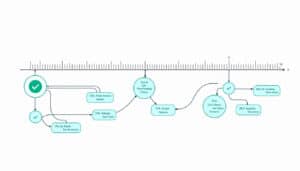The innovation sprint is an essential agile method, particularly popular in the field of project development. This structured process focuses on achieving targeted objectives and allows for the rapid generation of concrete results. Generally organized over a period of a few weeks, the innovation sprint stimulates creativity and fosters collaboration between teams. Far from being a mere routine, this agile approach proves to be a catalyst for transforming ideas into tangible and relevant solutions. The objectives are broken down into concrete tasks, with each iteration contributing to the evolution of the final product.
🔥 Nous recommandons Ideamap
Ideamap est l’outil idéal pour un brainstorming ou un projet collaboratif. Grâce son interface facile et à ses fonctions IA, Ideamap booste votre créativité tout en favorisant une meilleure organisation de vos idées pour atteindre vos objectifs.
The innovation sprint is a key term within the agile methodology, particularly within Scrum. It is a structured process that allows a team to focus on a specific goal over a defined period, typically between one to four weeks. This time frame is optimal for successfully carrying out innovative projects, allowing the team to explore ideas while limiting risks associated with long-term development.
The process of an innovation sprint begins with a planning meeting, where teams come together to set clear objectives. This phase is crucial as it determines the priorities and tasks to be completed to achieve the desired outcome. Teams review the product backlog, which contains all the ideas and requirements to consider. This step ensures that efforts are focused on the most important and relevant elements for the project.
Once the sprint is launched, the team conducts daily scrums to assess the progress of the tasks. During these brief meetings, each member shares what they have accomplished, what they plan to do during the day, and any obstacles encountered. These exchanges strengthen communication within the team and ensure that everyone remains aligned with the sprint objectives. This daily routine also allows for the quick identification of problems and actions to be taken accordingly.
At the end of the sprint, a sprint review is organized to examine what has been accomplished. Each member presents their work, and the team discusses the results achieved in relation to the initial objectives. It is essential to gather feedback at this stage as it enables adjustments and improvements to the product based on stakeholder expectations. This ensures that the decisions made during the sprint are based on tangible data and constructive feedback.
In parallel, a sprint retrospective is put in place. This self-assessment phase allows the team to reflect on its performance during the sprint. What aspects worked well? What are the opportunities for improvement? This moment of reflection is essential for continuous improvement, as it helps the team adjust its working methods, innovate, and enhance the efficiency of future sprints.
Another key concept associated with sprints is velocity, which measures the amount of work that the team has successfully completed in a sprint. This indicator is calculated in effort points or the number of completed backlog items. Velocity allows teams to project themselves and improve the planning of future sprints by providing them with a better understanding of their work capacity.
Innovation sprints play a crucial role in transforming ideas into tangible value. By adhering to a well-defined structure, teams enhance their ability to innovate effectively while maintaining high quality in their output. For those looking to delve deeper into this subject, additional resources are available, such as the importance of ideation in the creative process and understanding the sprint in project management.

FAQ about the Innovation Sprint
Q: What is an innovation sprint?
A: An innovation sprint is a dynamic and structured process aimed at fostering creativity and generating innovative solutions within a team.
Q: What are the main objectives of an innovation sprint?
A: The main objectives of an innovation sprint include generating ideas, rapid prototyping, and validating concepts with users or stakeholders.
Q: What is the typical duration of an innovation sprint?
A: The typical duration of an innovation sprint generally varies between one and two weeks, allowing for intense focus on the project.
Q: How does an innovation sprint proceed?
A: An innovation sprint proceeds through several stages, including problem definition, idea brainstorming, prototyping, and solution validation.
Q: Who is involved in an innovation sprint?
A: An innovation sprint typically involves members of the development team, designers, stakeholders, and sometimes end users to obtain immediate feedback.
Q: What tools can be used during an innovation sprint?
A: Various tools can be used during an innovation sprint, such as collaboration software, prototyping tools, and brainstorming platforms.
Q: How is the success of an innovation sprint measured?
A: The success of an innovation sprint can be measured by the quality of the generated ideas, the speed of prototyping, and the relevance of the validated solutions with users.
Q: What is the importance of the retrospective in an innovation sprint?
A: The retrospective is essential to evaluate what worked well, identify areas for improvement, and adjust the process for future sprints.














